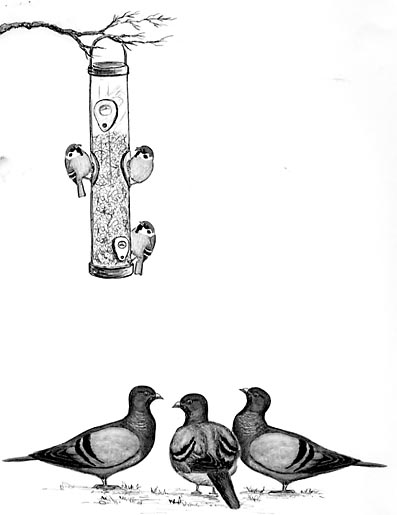
Dear Readers,
Note: This answer is a continuation from last week’s question. In case some of you have forgotten what you read last week (No Birds in Guam – 10/07/05) or have succeeded in blocking it out of your memory, I’ll do a quick review. Last week a woman named Brenda wrote in from Guam telling us that the only two species of birds living on that South Pacific island are the introduced House Sparrows* and pigeons. This is mostly true because another introduced species, the Brown Tree Snake, has nearly eaten every single native bird on the entire island. Brenda wanted to know how to keep the pigeons away so the sparrows could eat in peace. I, of course, wrote about the snakes eating all the birds and pretty much ignored her question. So this week we are focusing on Brenda and her pigeons. I don’t want the Guamese getting upset with me.
Pigeon complaints are a weekly occurrence. Guam isn’t alone with this problem. Pigeons are found in every city and are spreading to the suburbs almost as fast as Starbucks. They are abundant birds and instantly recognizable. Even the most birdingly-challenged individuals know what a pigeon is.
There’s been a slight name change though. In an interesting twist of name-that-bird, the books have always called this bird a “Rock Dove,” while the people have called it simply “pigeon.” Amazingly, in an effort to keep from looking out-of-step, the book people have caved-in and have officially changed the bird’s common name to “Rock Pigeon.” I’m not kidding. It is a great victory for the people, in a battle that they didn’t even know they were waging.
The history of humans and pigeons goes way back. The wild Rock Pigeons probably came from Eurasia, where they nested in rocks. Makes sense. Early man domesticated these pigeons for food and entertainment. That’s right, “entertainment.” You know things must have been dull back then when pigeons where considered the headliners. Since then millions of domesticated pigeons have escaped from their cages and have happily joined up with the wild birds. As a result, the pigeons that we see today are domesticated/feral. They have given up their love of nesting in rocks and instead have chosen to live near people. At least something still likes us.
The complaints I hear most about pigeons are that they are hogs and they are messy. While both of those claims may be true, we overlook the fact that the better part of a pigeon’s day is spent cleaning up after even bigger slobs, us. All day long pigeons are keeping our streets and sidewalks free of dropped chips, fries, nachos and Mrs. Field’s cookies. Without pigeons our city sidewalks would be so filled with scraps of food we wouldn’t be able to see the dried up gum, spit or chalk outlines.
Pay attention now Brenda. After two weeks of waiting, this is the part where I actually answer your question. The first step in keeping pigeons from dominating your feeder is to not use mixed seed. You should never use seed mixture anyhow, but especially if you don’t enjoy pigeons. Too much of that mixed crap gets dumped on to the ground and guess who’ll be there waiting for it. You should use hulled sunflower seed. Sunflower without hulls has no waste and no empty shells on the ground to attract the pigeons. Hulled sunflower is readily found on the mainland, but it is probably tough to find in Guam. You could try looking in a grocery or health food store. They may carry it to sell for people to eat. Ask one of the clerks, if the Brown Tree Snake hasn’t eaten them all.
The next thing to do is use a pigeon-proof feeder. Don’t use platform feeders, feeders with trays or those lame wooden feeders that look like ski chalets. Use a feeder that will close off the food if something heavy gets on it. Or use a tube style feeder with no perches or very short perches. Your sparrows don’t need much of a perch and tube feeders spill very little seed. And finally, don’t overfeed. The less food on the ground, the better the chance that your pigeons will go someplace else, although on Guam I’m not sure where that will be.
I almost made it to Guam once Brenda, but things changed. Maybe someday, I hope. If I ever get there I’ll look for you. I’ll be the one with binoculars around my neck and snake guards around both legs. It’s an odd look but I’m comfortable with it.
*By the way Brenda, I’m pretty sure that the sparrows you have are “Eurasian Tree Sparrows” and not “House Sparrows.” Look it up and see if I’m right. If I’m wrong, I’ll by you a coffee, at the Guam Starbucks.